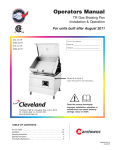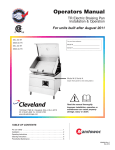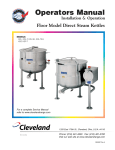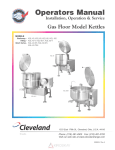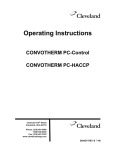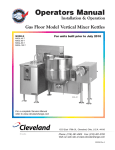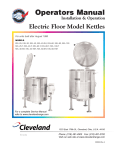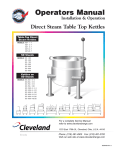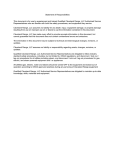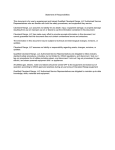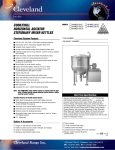Download Cleveland KGL-100 Operating instructions
Transcript
Operators Manual Gas Floor Model Kettles Installation & Operation For units built after April 2010 KGL-40, KGL-60, KGL-80, KGL-100 For your future reference. KGL-40-T, KGL-60-T, KGL-80-T Model # ______________________________________ KGL-40-SH, KGL-60-SH, Serial # _______________________________________ KGL-40-TSH KGL-40 KGL-40SH ! KGL-40-T ! ™ Cleveland Read the manual thoroughly. Improper installation, operation or maintenance can cause property damage, injury or death. 1333 East 179th St., Cleveland, Ohio, U.S.A. 44110 Ph: 216.481.4900 Fx: 216.481.3782 www.clevelandrange.com TABLE OF CONTENTS For your safety . . . . . . . . . . . . . . . . . . . . . . . . . . . . . . . . . . . . . . . . . . . . . . . 0 Installation . . . . . . . . . . . . . . . . . . . . . . . . . . . . . . . . . . . . . . . . . . . . . . . . . . . Operating Instructions . . . . . . . . . . . . . . . . . . . . . . . . . . . . . . . . . . . . . . . . . . Cleaning Instructions . . . . . . . . . . . . . . . . . . . . . . . . . . . . . . . . . . . . . . . . . . . Preventative Maintenance . . . . . . . . . . . . . . . . . . . . . . . . . . . . . . . . . . . . . . . 1 3 5 6 7 SE95003-1 EN Rev. 8 February 2012 FOR YOUR SAFETY / POUR VOTRE SÉCURITÉ / PARA SU SEGURIDAD FOR YOUR SAFETY POUR VOTRE SÉCURITÉ PARA SU SEGURIDAD Do not store or use gasoline or any other flammable liquids and vapours in the vicinity of this or any other appliance. Ne pas entreposer ou utiliser d'essence ou d'autres liquides ou vapeurs inflammables à proximité de cet appareil ou de tout autre appareil. No guarde ni use gasolina o cualesquiera otros líquidos o vapores inflamables en las cercanías de éste o cualquier otro aparato. WARNING: Improper installation, adjustment, alteration, service or maintenance can cause property damage, injury or death. Read the installation and operating instructions thoroughly before installing or servicing this equipment. AVERTISSEMENT : Une installation, un réglage, une modification, une réparation ou un entretien inadéquat peut occasionner des dommages matériels, des blessures ou la mort. Lire la notice de montage et d'exploitation avant d'installer ou d'entretenir cet équipement. ADVERTENCIA: La instalación, el ajuste, la alteración, el servicio o el mantenimiento incorrectos pueden ocasionar daños a la propiedad, lesiones o la muerte. Lea detenidamente las instrucciones de instalación y de operación antes de instalar o darle servicio a este equipo. This appliance is not to be used by persons with reduced physical, sensory or mental capabilities, or lack of experience and knowledge, unless they have been given supervision or instruction concerning use of the appliance by a person responsible for their safety. Cet appareil ne doit pas être utilisé par des personnes dont les capacités physiques, sensorielles ou mentales sont réduites, ou des personnes dénuées d'expérience ou de connaissance, sauf si elles ont pu bénéficier, par l'intermédiaire d'une personne responsable de leur sécurité, d'une surveillance ou d'instructions préalables concernant l'utilisation de l'appareil. Este aparato no debe ser utilizado por personas con capacidades físicas, sensoriales o mentales reducidas, o que no tengan la experiencia y los conocimientos adecuados, a menos que estas personas hayan recibido supervisión e instrucciones en cuanto al uso del aparato por la persona responsable de la seguridad de ellas. This appliance is not for use by children and they must be supervised not to play with it. Cet appareil n'est pas destiné à être utilisé par des enfants et ils doivent être surveillés pour s'assurer qu'ils ne jouent pas avec l'appareil. Post in a prominent location, instructions to be followed in the event the user smells gas. This information shall be obtained by consulting your local gas supplier. Affichez à un endroit bien visible les instructions à suivre dans le cas où l'utilisateur sent une odeur de gaz. Ces informations seront obtenues auprès de votre fournisseur de gaz local. Este aparato no debe ser usado por los niños y ellos deben ser supervisados para que no jueguen con el aparato. Do not obstruct the flow of combustion and ventilation air. Retain this manual for your reference. Ne pas obstruer le flux d'air de combustion et de ventilation. Conservez ce manuel pour votre référence 1. No obstruya el flujo del aire combustión y de ventilación. Guarde este manual para su referencia. FOR YOUR SAFETY / POUR VOTRE SÉCURITÉ / PARA SU SEGURIDAD Hazard warnings are for your safey. Absence of a CAUTION / ATTENTION / PRECAUCIÓN warning does not mean the hazard is not present. Unforeseen actions may result in unanticipated hazards. Keep clear of pressure relief discharge. / Restez à l'écart de la soupape de sureté. / Permanezca alejado de la descarga de presión. Les avertissements de danger sont pour votre sécurité. L’absence d'un avertissement ne signifie pas que le danger n'est pas présent. Les actions imprévues peuvent entraîner des dangers imprévus Keep hands away from moving parts and pinch points. / Gardez les mains loin des pièces mobiles et des points de pincement. / Mantenga las manos 0 lejos de piezas movibles y puntos de presión muy localizada. Las advertencias sobre los peligros son para su seguridad. La ausencia de una advertencia no significa que el peligro no está presente. Las acciones imprevistas podrían resultar en peligros no anticipados. Surfaces and product may be hot! Wear protective equipment. /Les surfaces et le produit peuvent être chauds! Portez un équipement de protection. / ¡Las superficies y el producto pueden estar calientes! Utilice equipo protector. IMPORTANT / IMPORTANT / IMPORTANTE Inspect unit daily for proper operation. / Inspectez l’unité tous les jours pour son bon fonctionnement. / Inspeccione diariamente el funcionamiento correcto de la unidad. Hot! / Chauds ! / ¡Caliente! 0 Do not fill kettle above recommended level marked on outside of kettle. / Ne remplissez pas la chaudière en excès du niveau recommandé marqué 0 sur la chaudière. / No llene la marmita arriba del nivel recomendado marcado fuera de la marmita. Do not climb, sit or stand on equipment. /Il ne faut pas monter, s'asseoir ni se tenir debout sur l'équipement. /No subirse, ni sentarse ni pararse sobre el equipo. GAS APPLIANCES / APPAREILS À GAZ / APARATOS A GAS Stand clear of product discharge path when discharging hot product. / Écartez-vous du chemin de décharge d’un produit chaud. / Permanezca alejado de la ruta de descarga del producto al vaciar producto caliente. Keep appliance and area free and clear of combustibles. / Gardez l'appareil et son entourage libre de tous combustibles. / Mantenga el aparato y el área libres de combustibles. Do not lean on or place objects on kettle lip. / Ne vous appuyez pas et ne placez pas d’objets sur le bec de la chaudière. / No se apoye o coloque objetos en el borde de la marmita. Do not attempt to operate this appliance during a power failure. / N’essayez pas de faire fonctionner cet appareil lors d'une panne de courant. / No intente poner en marcha este aparato durante un fallo de suministro eléctrico. SERVICING / ENTRETIEN / SERVICIO Shut gas supply off prior to servicing. / Fourniture de gaz fermée au loin avant d'entretenir. / Suministro de gas cerrado apagado antes del mantenimiento. Remove electrical power prior to servicing. / Coupez l'alimentation électrique avant l'entretien. / Desconecte la energía eléctrica antes de darle servicio. Unit exhaust contains carbon monoxide. Operate only under a properly functioning hood with adequate makeup air. / L'échappement de l'unité émet du monoxyde de carbone. Exploiter uniquement sous une hotte fonctionnant correctement avec une source adéquate d'air d'appoint. / El escape de la unidad contiene monóxido de carbono. Operar solamente bajo una campana en buen funcionamiento con aire de relleno adecuado. 0 2. Ensure kettle is at room temperature and pressure gauge is showing zero or less prior to removing any fittings. / Assurez-vous que la chaudière est à température ambiante et que le manomètre est à zéro ou moins avant de retirer des accessoires. / Asegúrese de que la marmita esté a temperatura ambiente y el manómetro esté mostrando cero o menos antes de retirar cualquier accesorio. INSTALLATION GENERAL 4. Cut strap holding unit. 5. Remove lag bolts from feet. 6. Remove manual from kettle pot. Write down the model# and serial# of the unit onto the front of this manual. 7. Lift kettle off skid and move kettle to its installation location. 8. Discard packaging material according to local and or state requirements. Insure gas and electrical supplies match rating plate. Installation of the kettle must be accomplished by qualified installation personnel working to all applicable local and national codes. This equipment is built to comply with applicable standards for manufacturers. Included among those approval agencies are: UL, NSF, ASME/N.Bd., CSA, ETL, and others. Many local codes exist, and it is the responsibility of the owner/installer to comply with these codes. Observe all clearance requirements. Do not obstruct the flow of combustion and ventilation air. Model/ Serial# RECEIVING INSPECTION Before unpacking visually inspect the unit for evidence of damage during shipping. If damage is noticed, do not unpack the unit, follow shipping damage instructions. Model/ Serial# SHIPPING DAMAGE INSTRUCTIONS If shipping damage to the unit is discovered or suspected, observe the following guidelines in preparing a shipping damage claim. 1. Write down a description of the damage or the reason for suspecting damage as soon as it is discovered. This will help in filling out the claim forms later. 2. As soon as damage is discovered or suspected, notify the carrier that delivered the shipment. 3. Arrange for the carrier's representative to examine the damage. 4. Fill out all carrier claims forms and have the examining carrier sign and date each form. VENTILATION Gas fired kettles are only to be installed under a ventilation hood in a room which has provisions for adequate make up air. Further information can be obtained by referring to the U.S.A. National Fire Protection Associations NFPA96 regulations. These standards have also been adopted by the National Building Code in Canada. UNCRATING POSITIONING Caution: Straps under tension and will snap when cut. This unit must be installed in accordance with the clearances shown on the rating label which is adhered to the unit. Carton may contain staples and Skid contains Nails. RIGHT LEFT Tilting 0 0 Stationary 3” 3” Allow 12” minimum on right for service. Use proper safety equipment and precautions. Unit is heavy use adequate help or lifting equipment as needed. 1. Carefully cut any straps from container. 2. Lift off carton. 3. Inspect for hidden damage. If found refer to “SHIPPING DAMAGE INSTRUCTIONS”. REAR 3” 3” 1. Position the unit in it's permanent location, and level the unit by turning the adjustable feet. 2. Once positioned and leveled, permanently secure the unit's flanged feet to the floor using 5/16" lag bolts and floor anchors (supplied by the installer). Three bolts are required to secure each of the flanged feet. 3. Seal joints of flanged feet with a silicone sealant. 4. Remove any protective material covering the stainless steel panels. 3. GAS NOTE: Units are tested on a in-house ground fault system. However, there is no guarantee the unit will work on all ground fault systems. If you are having problems you can hard wire the unit. ENSURE THE GAS SUPPLY MATCHES THE KETTLE'S REQUIREMENTS AS STATED ON THE RATING PLATE. Installation must conform, with local codes or in the absence of local codes, with the National Fuel Gas Code ANSI Z223.1/NFPA 54, or the Natural Gas and Propane Installation Code, CSA B149.1. The appliance and its individual shut-off valve must be disconnected from the gas supply piping system during any pressure testing of that system at test pressures in excess of 1/2 psi (3.45 kPa). The appliance must be isolated from the gas supply piping system by closing its individual manual shut-off valve during any pressure testing of the gas supply piping system at test pressures equal to or less than 1/2 psi (3.45 kPa). It is recommended that a sediment trap (drip leg) be installed in the gas supply line. If the gas pressure exceeds 1/2 psi (3.45 kPa) water column, a pressure regulator must be installed, to provide a maximum of 1/2 psi (3.45 kPa) water column gas pressure to the gas control valve. Use a gas pipe joint compound which is resistant to L.P. gas. Test all pipe joints for leaks. 1. Removed supplied manual shut-off valve and establish mounting location. 2. Add union and piping as required. GAS SUPPLY 3. Connect the gas NIPPLE SHUT-OFF UNION line to the manual VALVE shut-off valve. WATER The sealed jacket of the gas-fired kettle is precharged with the correct amount of a water-based formula, and therefore, no water connection is required to the kettle jacket. The kettle can be equipped with optional hot and cold water taps, requiring 1/2" copper tubing as supply lines. CLEANING After installation the kettle must be thoroughly cleaned and sanitized prior to cooking. INSTALLATION CHECKS BACK OF KETTLE Although the kettle has been thoroughly tested before leaving the factory, the installer is responsible for ensuring the proper operation of kettle once installed. 1. Before turning the kettle on, read the vacuum/pressure gauge. The gauge's needle should be in the green zone. If the needle is in the "VENT AIR" zone, follow air venting procedure. 2. Unit has been thoroughly checked for gas leaks at the factory however the installer should check all connections for any leaks which may have resulted from shipping or installation. 3. Supply power to the kettle by placing the fused disconnect switch to the "ON" position. 4. Open gas shut-off valve to turn on main gas supply. 5. Turn the temperature control knob to "1" (Min.). The green LED light should remain lit, indicating the burner is lit, until the set temperature is reached. Then the green light will cycle on and off, indicating the burner is cycling on and off to maintain temperature. 6. Tilt the kettle forward. After a few seconds the red "LOW WATER" light should be lit when the kettle is in a tilted position. This light indicates that the burner has automatically been shut off by the kettle's safety circuit. This is a normal condition when the kettle is in a tilted position. 7. Raise the kettle to the upright position. The red "LOW WATER" light should go out when the kettle is upright. 8. Turn the temperature control knob to "10" (Max.) and allow the kettle to preheat. The green light should remain on until the set temperature is reached. Then the green light will cycle ON and OFF, indicating the burner is cycling ON and OFF to maintain temperature. 9. Check carbon monoxide is less than 0.08 percent in an air-free sample of the flue gases. See FREE AIR CALCULATION procedure in “Maintenance Procedures & Parts Lists” manual. ELECTRICAL ENSURE THE ELECTRICAL SUPPLY MATCHES THE KETTLE'S REQUIREMENTS AS STATED ON THE RATING LABEL. A cord and plug are supplied with the unit. Simply plug the unit into any grounded outlet rated for a minimum of 10 amps. The kettle must be electrically installed and grounded in accordance with local codes, or in the absence of local codes, with National Electrical Code, ANSI/NFPA 70 (USA) or WARNING: Electrical Grounding Instructions. This unit is equipped with a three-prong (grounding) plug for your protection against shock hazard and should be plugged directly into a properly grounded three-prong receptacle. Do not cut or remove the grounding prong from this plug. the Canadian Electrical Code, CSA C22.2, (Canada). Standard supply voltage is 115 volts A.C., however, optional A.C. voltages can be supplied on special order. A separate fused disconnect switch must be supplied and installed in the high voltage electrical supply line. The wiring diagram is located under the cover of electrical box inside the back console. 4. 0 OPERATING INSTRUCTIONS OPERATING THE KETTLE ! 1. Temperature Control Setting OPERATING CONTROLS AND INDICATORS 8 5 1 2 3 9 Approximate Product Temperature °F °C 1. 2. 120 135 49 57 3. 4. 5. 6. 7. 8. 9. 10. 150 165 180 195 210 225 245 265 66 74 82 91 99 107 118 130 NOTE: Certain combinations of ingredients will result in temperature variations 4 6 Perform daily startup inspection. 2. 4 7 1. LOW WATER INDICATOR LIGHT (RED) Preheat the kettle by turning the ON/OFF Temperature Control to the desired temperature setting. The Heat Indicator Light (Green) will remain lit, indicating the burner is on, until the temperature setting is reached. When the green light goes off, the burners are off, and preheating is complete. NOTE: When cooking egg and milk products, the kettle should not be preheated, as products of this nature adhere to hot cooking surfaces. When lit, indicates that the kettle is low on water and will not operate in this condition. This will also light when the kettle is in the tilted position. 2. ON-OFF TEMPERATURE CONTROL ! 3. Place food product into the kettle. The green Heat Indicator Light will cycle on and off indicating the burners are cycling on and off to maintain the set temperature. 4. When cooking is completed turn Temperature Control to the "OFF' position. 5. Pour the contents of the kettle into an appropriate container by tilting the kettle forward or using discharge0 valve. Turns kettle ON/OFF and allows the operator to adjust the kettle 0 temperature. 3. HEAT INDICATOR LIGHT (GREEN) When lit, indicates that the kettle's burner is on. Cycles ON-OFF with burner. 4. VACUUM/PRESSURE GAUGE Indicate steam pressure in PSI inside steam jacket and vacuum in inches of mercury. 5. PRESSURE RELIEF VALVE (NOT SHOWN) This valve is used to vent the kettle and in the unlikely event there is an excess steam build-up in the jacket. 6. WATER LEVEL SIGHT GLASS Displays water level in steam jacket. 7. TILT WHEEL NOTE: Cleaning should be completed immediately after cooked foods are removed. Used for tilting the kettle on hand tilt models. NOTE: A five minute complete shut-of period is required before relighting. 8. FLUE Exit for combustion gasses. 9. TANGENT DRAW-OFF VALVE Used for draining product or wash water from kettle. 0 5. 0 CLEANING INSTRUCTIONS 0 CLEANING INSTRUCTIONS CARE AND CLEANING Cooking equipment must be cleaned regularly to maintain its fast, efficient cooking performance and to ensure its continued safe, reliable operation. The best time to clean is shortly after each use (allow unit to cool to a safe temperature). 0 1. Turn unit off. 2. Remove drain screen (if applicable). Thoroughly wash and rinse the screen either in a sink or a dishwasher. 3. Prepare a warm water and mild detergent solution in the unit. 4. Remove food soil using a nylon brush. 5. Loosen food which is stuck by allowing it to soak at a low temperature setting. 6. Drain unit. 7. Rinse interior thoroughly. 8. If the unit is equipped with a Tangent Draw-Off Valve, clean as follows: a) Disassemble the draw-off valve first by turning the valve knob counterclockwise, then turning the large hex nut counter-clockwise until the valve stem is free of the valve body. b) In a sink, wash and rinse the inside of the valve body using a nylon brush. c) Use a nylon brush to clean tangent draw-off tube. d) Rinse with fresh water. e) Reassemble the draw-off valve by reversing the procedure for disassembly. The valve's hex nut should be hand tight only. WARNINGS Do not use detergents or cleansers that are chloride based or contain quaternary salt. 9. Chloride Cleaners Do not use a metal bristle brush or scraper. If the unit is equipped with a Butterfly Valve, clean as follows: a) b) c) d) e) Place valve in open position. Wash using a warm water and mild detergent solution. Remove food deposits using a nylon brush. Rinse with fresh water. Leave valve open when unit is not in use. 10. If the unit is equipped with an Air Valve, clean as follows: Wire Brush & Scrapers Steel wool should never be used for cleaning the stainless steel. Steel Pads Unit should never be cleaned with a high pressure spray hose. High Pressure Spray Hose Do not leave water sitting in unit when not in use. a) b) c) d) e) f) g) h) i) j) k) l) Open product valve. Disconnect air hoses. Remove air cylinder. Remove valve tee. Remove all O-rings. Clean air cylinder, do not submerge in water. Wipe clean and sanitize. Clean and sanitize tee and O-rings. Grease and reinstall O-rings. Reinstall valve tee to kettle outlet. Reinstall air cylinder to bottom of tee. Reconnect air hoses. Close valve and check for alignment. 11. Using mild soapy water and a damp sponge, wash the exterior, rinse, and dry. NOTES ➩ For more difficult cleaning applications one of the following can be used: alcohol, baking soda, vinegar, or a solution of ammonia in water. ➩ Leave the cover off when the kettle is not in use. ➩ For more detailed instructions refer to Stainless Steel Equipment Care and Cleaning (www.nafem.org/resources/stainlesssteelfinal.doc) on Nafem’s website (www.nafem.org). Stagnant Water 6. PREVENTATIVE MAINTENANCE FOR MAINTENANCE AND REPAIRS CONTACT YOUR AUTHORIZED MANITOWOC SERVICE AGENCY AND HAVE A QUALIFIED SERVICE TECHNICIAN MAINTAIN YOUR EQUIPMENT. ! Shut off power at main fuse disconnect prior to servicing. 0 Ensure kettle is at room temperature and pressure gauge is showing zero or less prior to removing0any fittings.0 C DAILY PRE-STARTUP INSPECTION D A (not shown) G F H 1. Flue (A) is not obstructed. 2. Draw-Off Valve (B) is installed and handle is in place. 3. Knob (C) not missing from spring assist handle. 4. Cover (D) lifts up and down freely and is held in place when fully open. B 5. Pressure Gauge (E) is in the green when unit is cold. 6. Green Light (F) comes on when unit is energized. 7. Red Light (G) comes on when unit is tilted (tilting models only). E SIX MONTH SERVICE INSPECTION 1. 2. 3. 4. 5. 6. 7. 8. Perform daily startup inspection. Gasket (H) around top cover is in good condition. Tilt hand (J) wheel is tight. Grease bearings on both trunnions. Check for play in gears (adjust if required). Fasteners securing panels are in place and tight. Perform pressure relief valve periodic test (see PRESSURE RELIEF VALVE TESTING). Adequate exhaust and makeup air is supplied to working area. YEARLY SERVICE INSPECTION 1. Perform six month service inspection. 2. Check kettle maximum temperature setting (see CALIBRATING PROCEDURE). 3. Perform pressure relief valve periodic test (see PRESSURE RELIEF VALVE TESTING). 4. Inspect safety thermostat for proper connections (see SAFETY THERMOSTAT). 5. Inspect Low water probe for proper connections (see LOW WATER LEVEL PROBE). 6. Inspect safety valve installation (see SAFETY VALVE INSTALLATION). 7. Clean blower. 8. Perform free air calculation (see FREE AIR CALCULATION). 7. J








